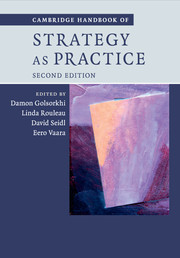Book contents
- Frontmatter
- Contents
- List of figures
- List of tables
- List of boxes
- List of contributors
- Preface to the Second Edition
- Introduction: what is strategy as practice?
- Part I Ontological and Epistemological Questions
- Part II Theoretical Resources: Social Theory
- Part III Theoretical Resources: Organization and Management Theories
- Part IV Methodological Resources
- Part V Substantive Topic Areas
- 31 Strategic planning as practice
- 32 Meetings and workshops as strategy practices
- 33 The role of materiality in the practice of strategy
- 34 Strategy-as-practice research on middle managers’ strategy work
- 35 Participation in strategy work
- 36 The role of emotions in strategizing
- Index
- References
32 - Meetings and workshops as strategy practices
from Part V - Substantive Topic Areas
Published online by Cambridge University Press: 05 October 2015
- Frontmatter
- Contents
- List of figures
- List of tables
- List of boxes
- List of contributors
- Preface to the Second Edition
- Introduction: what is strategy as practice?
- Part I Ontological and Epistemological Questions
- Part II Theoretical Resources: Social Theory
- Part III Theoretical Resources: Organization and Management Theories
- Part IV Methodological Resources
- Part V Substantive Topic Areas
- 31 Strategic planning as practice
- 32 Meetings and workshops as strategy practices
- 33 The role of materiality in the practice of strategy
- 34 Strategy-as-practice research on middle managers’ strategy work
- 35 Participation in strategy work
- 36 The role of emotions in strategizing
- Index
- References
Summary
Introduction
From the strategy-as-practice perspective, strategy is what people do in organizations (Jarzabkowski, Balogun and Seidl 2007; Johnson et al. 2007; Johnson, Melin and Whittington 2003; Vaara and Whittington 2012; Whittington 2006), and one thing people tend to do often in organizations when they strategize is to take part in meetings. This is hardly surprising, considering that meetings represent one of the most pervasive practices in organizations (Schwartzman 1989). Some early studies on meetings found that they occupy between 59 per cent and 69 per cent of managers’ time (Dahl and Lewis 1975; Mintzberg 1973). Moreover, many studies stress that meetings undeniably offer space in which different strategic views can be shared and disputed (Gailbraith 1973; Guetzkow and Kriesberg 1950; Kwon, Clarke and Wodak 2014; Mintzberg 1973).
Surprisingly, it was only relatively recently that researchers began to take an interest in how meetings and workshops affect strategizing practices (Hodgkinson et al. 2006; Jarzabkowski and Seidl 2008). In fact, meetings were traditionally seen as useless and irrelevant or as nothing more than a ‘neutral’ frame for decision-making processes (see Schwartzman 1989 for more details). Now, however, it is widely recognized that meetings shape the activities that take place within their span. Recent studies have examined from various angles how meetings influence strategy. The most often researched topics include: how meetings and the discursive practices associated with them affect the development of shared views on strategic issues (Clarke, Kwon and Wodak 2012; Kwon, Clarke and Wodak 2014; Wodak, Kwon and Clarke 2011), how meetings enable ‘strategy talk’ and the production of ‘strategy text’ (Spee and Jarzabkowski 2011), how the display of emotions in meetings influences the way in which strategic issues are discussed and evaluated (Liu and Maitlis 2014), how strategic meetings bring middle and senior managers together to negotiate over and agree on consistent collective action (Hoon 2007), how board meetings influence strategy-making (McNulty and Pettigrew 1999), how ‘rituals’ in workshops affect strategic outcomes (Johnson et al. 2010) and how strategy is changed and stabilized through series of meetings (Jarzabkowski and Seidl 2008). All these studies indicate that meetings and workshops have become an established and important research area within the field of strategy as practice.
- Type
- Chapter
- Information
- Cambridge Handbook of Strategy as Practice , pp. 564 - 581Publisher: Cambridge University PressPrint publication year: 2015
References
- 17
- Cited by

